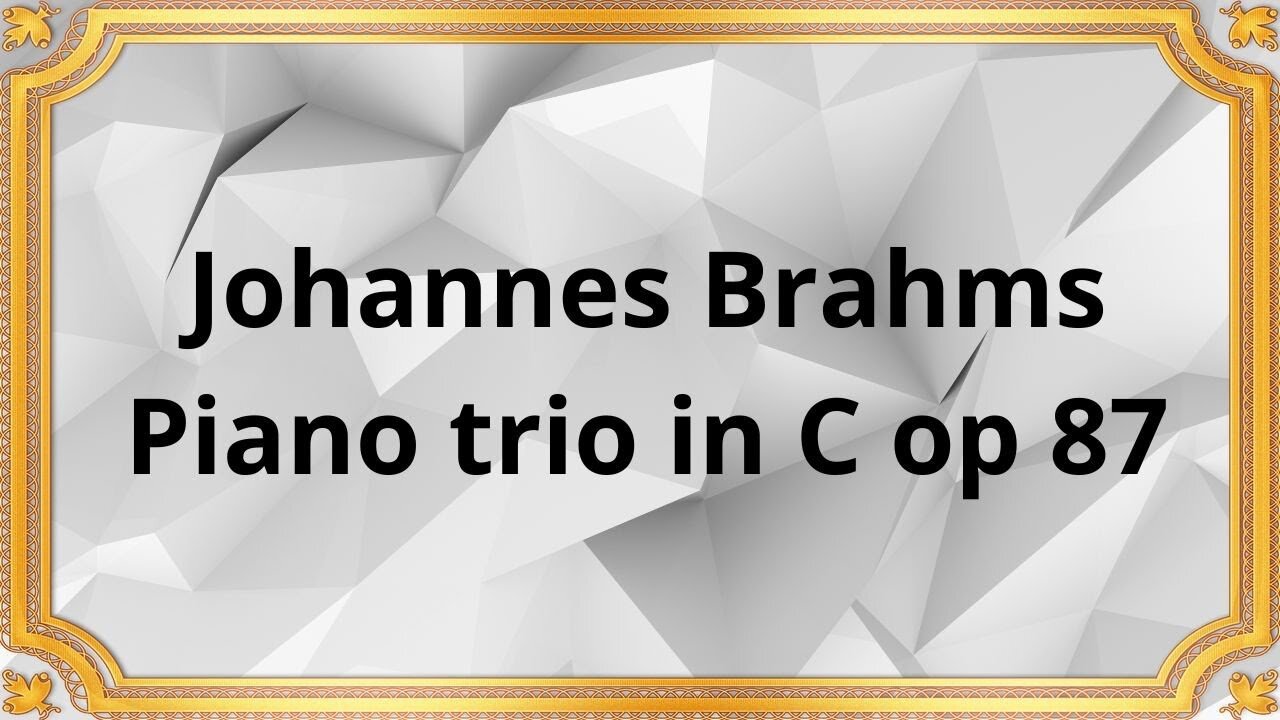Premium Only Content

Johannes Brahms Piano trio in C op 87
#Brahms #ClassicalMusic #PianoTrio #CMajor #Opus87 #MusicalComposition #Composer #JohannesBrahms
Publication date 1929
Hirt Trio:
Franz-Joseph Hirt, piano
Alphonse Brun, violin
Lorenz Lehr, cello
Johannes Brahms' Piano Trio in C, Op. 87, is a remarkable and influential composition that exemplifies the genius and mastery of one of the most celebrated composers of the Romantic era. Written in 1882, this piano trio stands as a testament to Brahms' profound musicality and his ability to create works of depth and emotional richness.
The Piano Trio in C, Op. 87, is a four-movement work that showcases Brahms' distinctive style and his deep understanding of chamber music. The first movement, marked Allegro, opens with a bold and passionate theme presented by the piano. The string instruments, the violin and cello, then join in, engaging in a musical dialogue with the piano. The movement exhibits Brahms' characteristic use of rich harmonies, intricate counterpoint, and compelling melodies that are developed throughout the movement. The interplay between the instruments creates a sense of drama and intensity, captivating the listener from the very beginning.
The second movement, marked Andante con moto, offers a contrasting mood of lyrical beauty and introspection. It begins with a hauntingly beautiful melody presented by the cello, accompanied by the piano. The violin then takes up the melody, creating a sense of dialogue and musical conversation. Brahms' mastery of expressive and emotive writing is evident in this movement, as he weaves together the voices of the three instruments, creating a profound sense of longing and introspection.
The third movement, marked Scherzo: Presto, is a lively and energetic dance-like movement that showcases Brahms' rhythmic inventiveness and his ability to create captivating and virtuosic passages. The movement is characterized by its playful and spirited themes, rapid passages, and intricate interplay between the piano and the strings. Brahms' skillful use of dynamics and contrasting sections adds depth and excitement to this movement, captivating the listener with its energy and technical brilliance.
The final movement, marked Allegro giocoso, brings the Piano Trio to a triumphant and exhilarating conclusion. It is a vibrant and spirited movement, filled with rhythmic drive, catchy melodies, and moments of virtuosic brilliance. Brahms' use of contrapuntal techniques, such as canonic writing, adds complexity and depth to the music, creating a thrilling and satisfying finale.
Johannes Brahms' Piano Trio in C, Op. 87, is a testament to the composer's exceptional skill in crafting chamber music of profound emotional depth and complexity. Through its four movements, this piano trio showcases Brahms' mastery of form, his gift for melody, and his ability to create a wide range of emotions in his compositions.
This musical masterpiece continues to captivate audiences with its timeless beauty and enduring appeal. Its rich harmonies, expressive melodies, and intricate interplay between the piano and strings make it a cherished work in the chamber music repertoire. Brahms' Piano Trio in C, Op. 87, stands as a testament to his musical genius and serves as a reminder of his significant contributions to the world of music.
In conclusion, Johannes Brahms' Piano Trio in C, Op. 87, is a magnificent and influential composition that exemplifies the composer's profound musicality and his ability to create works of exceptional depth and emotional richness. Through its four movements, this piano trio showcases Brahms' mastery of form, his gift for melody, and his unique ability to evoke a wide range of emotions in his compositions. It remains a cherished and celebrated piece in the classical music canon, forever reminding us of Brahms' extraordinary talent and his lasting impact on the world of music.
You have the opportunity to support the channel https://destream.net/live/RadSiarAl/donate
-
 14:44
14:44
Classical music_Music Inspiration
3 months agoLudwig van Beethoven Sonata No. 14 in C-Sharp Minor, Op. 27, No. 2 "Moonlight"
88 -
 1:01:53
1:01:53
BonginoReport
12 hours agoPolitical Violence on the Rise in America - Nightly Scroll w/Hayley Caronia (Ep.26) - 04/14/2025
161K101 -
 1:32:42
1:32:42
BlackDiamondGunsandGear
7 hours agoThey Don’t want you to Purchase 2A Related Products?
48.9K3 -
 2:53:36
2:53:36
Joe Pags
10 hours agoThe Joe Pags Show 4-14-25
111K -
 56:14
56:14
Sarah Westall
10 hours agoGlobal Agenda: Starve Small Business of Funds w/ Bruce De Torres
92.2K23 -
 2:17:29
2:17:29
2 MIKES LIVE
13 hours ago2 MIKES LIVE #205 with guest Nick Adams!
67.1K -
 54:38
54:38
LFA TV
17 hours agoThe Bread of Life | TRUMPET DAILY 4.14.25 7PM
66.7K16 -
 37:52
37:52
Kimberly Guilfoyle
12 hours agoThe Trump Effect, Plus More Scandals for Leticia James, Live with Roger Stone | Ep213
84.7K28 -
 1:13:45
1:13:45
Kim Iversen
12 hours agoWe're LOSING The Tariff War With China, How Our Elites Sold Us Out | Oct 7th Rape COVERUP
109K221 -
 1:23:13
1:23:13
Redacted News
13 hours agoTrump declaring MARTIAL LAW on April 20th according to fearmonger liberals, they want civil war
175K253